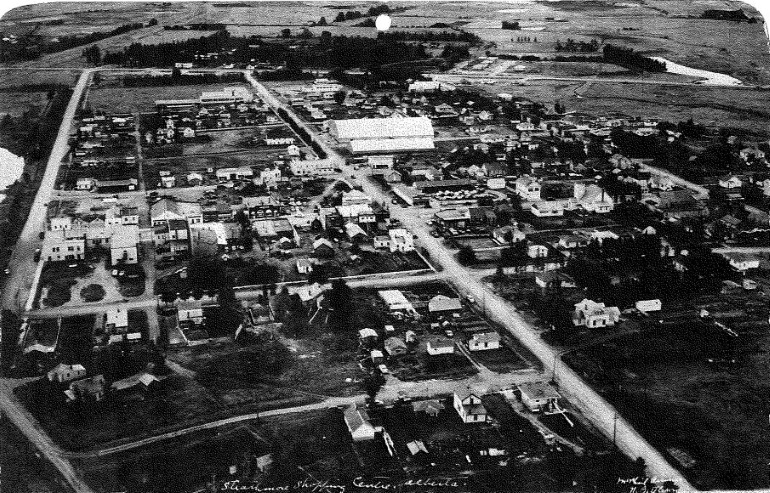The town of Strathmore is undergoing revitalization. But at the same time, the community is marking over 100 years of existence. On March 20, 1908, Strathmore was incorporated as a Village. Within that span of time, the town has seen a number of struggles, from the establishment of the railroad near Eagle Lake to a thriving pioneer downtown, and later a raging fire and reconstruction of the community.
Local historians Tom Sadler and Lynne Fair from the Western District Historical Society spoke about the community’s rural roots and some of the trials early settlers faced to build Strathmore into the municipality it is today.
Sadler explained it all began with the construction of the railway through the area in the summer of 1883.
“At that time the Strathmore siding was located at the southwest corner of Eagle Lake. But it was never developed as a townsite down there all they had was a shipping point. They had watering stations in Gleichen and in Langdon for the railway, they were the major stopping points for the railway in the early days but the cattle were all in the free-range, they roamed all over southern Alberta.”
A huge round-up would take place each fall that began near the Bar U Ranch by High River and made its way South and East around the Snake River Valley, or the Lake McGregor region.
“They would round all the cattle up and swinging north across the Bow River down around by Brooks and back West again and bring them over into this area where they were shipped,” said Sadler.
Then came the irrigation district in 1905. They moved from the shores of Eagle Lake to Strathmore.
"It grew extremely rapidly because CPR moved in the work crews and the engineers. and within three years from 1905, it actually was incorporated as a village, so it grew very rapidly at the new site here."
During that time period fire was destructive to many local communities, whether from prairie fires or fires caused by kerosene lamps and candles.
One of the local history books is called ‘ Along the fireguard trail.’ Something people may not know about Strathmore is that in the early days the fireguard trail was the road about 4 miles north of Highway 1.
“It ran clear across the county and it actually was a fireguard because beyond that was all open range and so it was to protect the people of Strathmore from prairie fires,” said Sadler.
Walking through the downtown of Strathmore visitors can still see remnants of the part, historical landmarks that led to the development of communities in Western Canada.
Devastating prairie fires
Strathmore was not so lucky to avoid destruction by fire.
Lynne Fair explained, “Originally all the Prairie towns were of course just built of old wooden buildings which were very susceptible to fires because everybody either burned coal or you had candles or kerosene lamps.”
In Strathmore in1924 a fire started in the upstairs of what was the old Opera House.
“The fire started there, which was on the north side of Main Street, and very rapidly took off,” she said. The fire department at the time was very small and only consisted of about one truck and a few volunteers.
“The entire north part of Main Street just about all entirely burnt down and fortunately got stopped before it took the big Union Bank building on the West end of Main Street. But it did jump across the street unfortunately and takedown about 1/2 or a Third of the southside,” she said.
The great reconstruction
What’s amazing was the resiliency of the community and its ability to rebuild.
Today, if you walk through some of the back alleys in the downtown region of Strathmore you can see how the town developed a number of brick firewalls to prevent the spread of fires and ensure the continued survival of the community.
About the impact on the community, she said, “I guess it shows you the resiliency of those early business people and townsfolk.”
Sadler said, “One of the first to initiate rebuilding was the Opera House itself, where the fire had started they restarted immediately in 1924 to rebuild there.” The site is now what is known as the Joyland Theatre.
A few of the surviving buildings on the West side of town include the old Anglican Church, the Great War Memorial Hall at the Legion, the AGT brick building, and the Union Bank building from 1910.
Fair explained that the best source of Strathmore's history is in the green history book called 'The Village That Moved.' The history book also includes a lot of the family histories of early Strathmore residents.
There are copies of the book at the Strathmore Municipal Library and at the Vault Cultural Collective thanks to the Western District Historical Society.
A secondary centennial history book from 2012 also documents Strathmore history including excerpts from the old Strathmore Standard newspaper.
In the future, there is a hope to have a visitor’s or information center where people will be able to gain information about Strathmore’s history.
The Western District Historical Society has been able to preserve some of that information in showcases located at the Strathmore Legion, the Lambert Centre, The Vault Culture Collective building, and at the Wheatland County municipal office.







